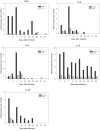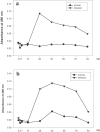Changes of cytokine mRNA expression and IgG responses in rats infected with Capillaria hepatica
- PMID: 17570971
- PMCID: PMC2526303
- DOI: 10.3347/kjp.2007.45.2.95
Changes of cytokine mRNA expression and IgG responses in rats infected with Capillaria hepatica
Abstract
The mRNA expression of several cytokines was evaluated in splenocytes and mesenteric lymph node (MLN) cells of rats infected with Capillaria hepatica by reverse-transcription (RT)-PCR until week 12 after infection. IgG1 and IgG2a, which are associated with Th1 and Th2 response, respectively, were also assessed by ELISA. The results indicated that the majority of cytokines, including the Th1 (IL-2 and IFN-gamma) and Th2 cytokines (IL-4, IL-5 and IL- 10) were expressed at maximal levels during the early stage of infection (after week 1-2), and the ELISA data also evidenced a similar pattern of changes in IgG1 and IgG2a. Th1 and Th2 cytokines responded in a similar fashion in this rat model. The expression of cytokines in splenocytes was significantly higher than that in MLN cells, thereby indicating that cytokine production is controlled more by spleen than by MLN. In addition, the observation that IFN-gamma expression increased unexpectedly at the time of maximal egg production (6 weeks after infection) indicated that IFN- gamma is a cytokine reacting against egg production. However, increased IL-5 expression occurring in tandem with worm activity indicated that the activity of C. hepatica might be controlled by IL-5 expression.
Figures



Similar articles
-
Th2-related cytokines are associated with Fasciola gigantica infection and evasion in the natural host, swamp buffalo.Vet Parasitol. 2019 Apr;268:73-80. doi: 10.1016/j.vetpar.2019.03.001. Epub 2019 Mar 26. Vet Parasitol. 2019. PMID: 30981309
-
Fasciola hepatica infection downregulates Th1 responses in mice.Parasite Immunol. 2000 Mar;22(3):147-55. doi: 10.1046/j.1365-3024.2000.00290.x. Parasite Immunol. 2000. PMID: 10672196
-
Immune responses induced by co-infection with Capillaria hepatica in Clonorchis sinensis-infected rats.J Helminthol. 2018 Jul;92(4):395-402. doi: 10.1017/S0022149X17000682. Epub 2017 Aug 8. J Helminthol. 2018. PMID: 28784187
-
Signals involved in the early TH1/TH2 polarization of an immune response depending on the type of antigen.J Allergy Clin Immunol. 1999 Feb;103(2 Pt 1):298-306. doi: 10.1016/s0091-6749(99)70505-1. J Allergy Clin Immunol. 1999. PMID: 9949322
-
Serological detection of Capillaria hepatica by indirect immunofluorescence assay.J Clin Microbiol. 2000 Jan;38(1):431-3. doi: 10.1128/JCM.38.1.431-433.2000. J Clin Microbiol. 2000. PMID: 10618135 Free PMC article. Review.
Cited by
-
Discovery of two highly divergent negative-sense RNA viruses associated with the parasitic nematode, Capillaria hepatica, in wild Mus musculus from New York City.J Gen Virol. 2019 Oct;100(10):1350-1362. doi: 10.1099/jgv.0.001315. Epub 2019 Sep 12. J Gen Virol. 2019. PMID: 31513008 Free PMC article.
-
Capillaria hepatica in China.World J Gastroenterol. 2010 Feb 14;16(6):698-702. doi: 10.3748/wjg.v16.i6.698. World J Gastroenterol. 2010. PMID: 20135717 Free PMC article. Review.
-
Luna Virus and Helminths in Wild Mastomys natalensis in Two Contrasting Habitats in Zambia: Risk Factors and Evidence of Virus Dissemination in Semen.Pathogens. 2022 Nov 14;11(11):1345. doi: 10.3390/pathogens11111345. Pathogens. 2022. PMID: 36422597 Free PMC article.
-
Concomitant influence of helminth infection and landscape on the distribution of Puumala hantavirus in its reservoir, Myodes glareolus.BMC Microbiol. 2011 Feb 8;11(1):30. doi: 10.1186/1471-2180-11-30. BMC Microbiol. 2011. PMID: 21303497 Free PMC article.
References
-
- Carpon A. Immunity to schistosomes. Curr Opin Immunol. 1992;4:419–424. - PubMed
-
- Cetre C, Cocude C, Pierrot C, Godin C, Capron A, Capron M, Khalife J. In vivo expression of cytokine mRNA in rats infected with Schistosoma mansoni. Parasite Immunol. 1998;20:135–142. - PubMed
-
- Choe G, Lee HS, Seo JK, Chai JY, Lee SH, Eom KS, Chi JG. Hepatic capillariasis: first case report in the Republic of Korea. Am J Trop Med Hyg. 1993;48:610–625. - PubMed
MeSH terms
Substances
LinkOut - more resources
Full Text Sources

